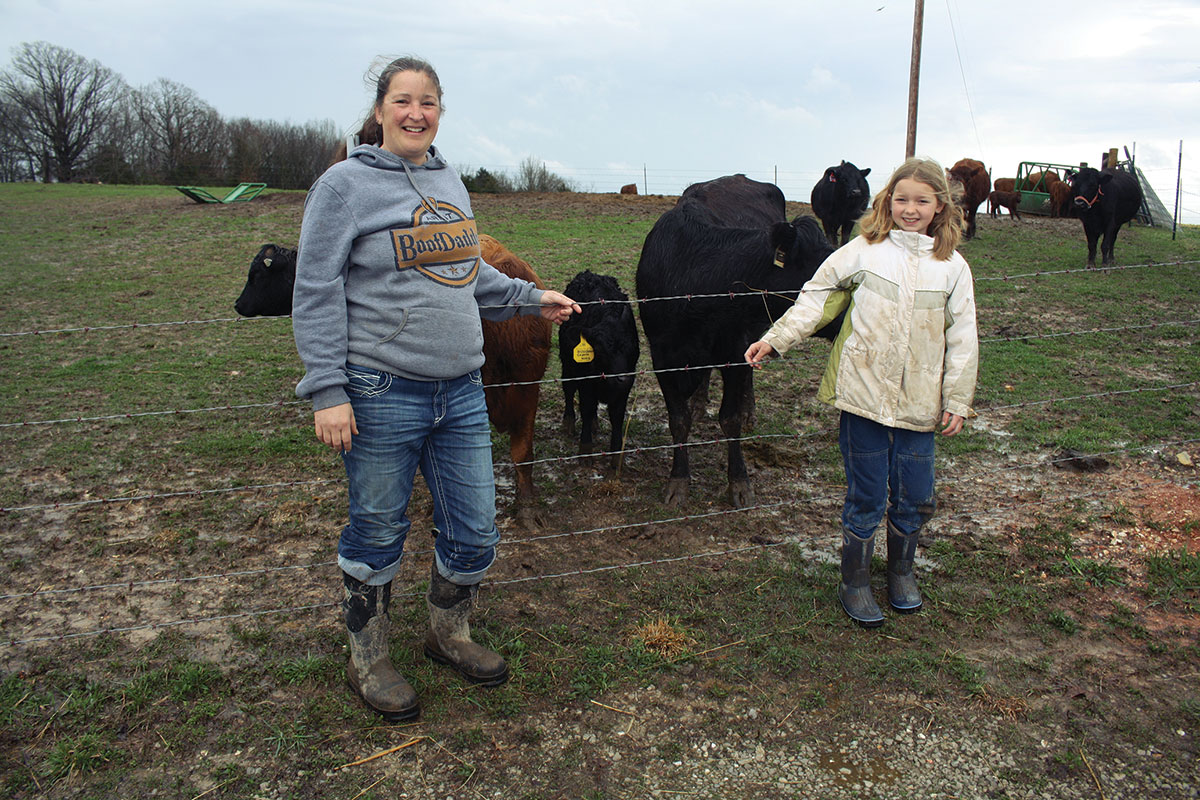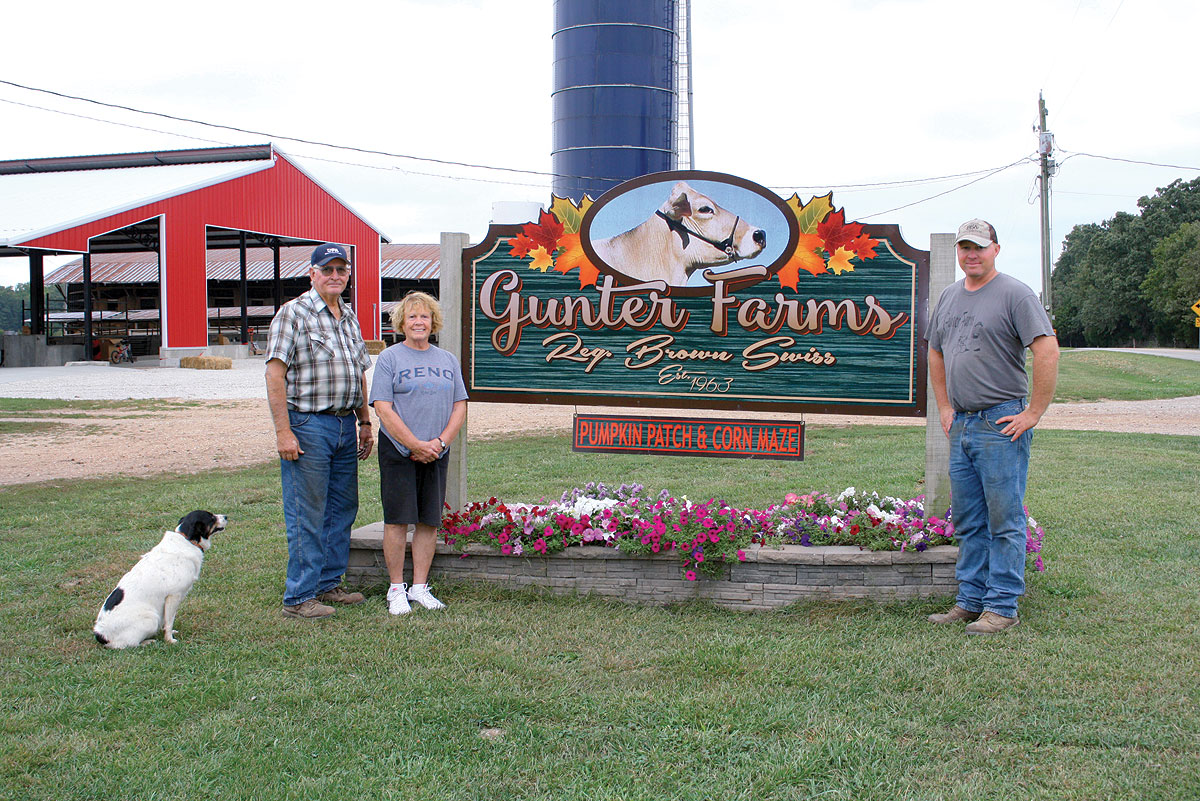
The Heilig family is sold on Dexter cattle and the Ozarks
Trips to the Ozarks from Colorado kept getting a little longer for the Heilig family.
At first, it was for a day or two, then a week, then two weeks. After a couple of years, Matt and Carmine Heilig decided it was time to make the move to Southwest Missouri. They packed up their family and moved to a farm in rural Niangua, Mo., in 2019.
The family initially began a herd of miniature Herefords for beef and Nubian goats for milk in Colorado, but they realized those animals were not what they wanted. After a little research they went to the dual-purpose Dexter. The breed is a smaller-framed animal that does well on a forage-based diet and produces component-rich milk.
“We also like the Dexters because they are so gentle,” Carmine said of their 30-head herd. “We have eight kids (ages 17 to 1), so we wanted something small and compact that would feed our family and something we could milk. Dexters are hands down the best family cow.”
In addition to the beef and dairy aspects of the breed, the Heiligs appreciate the reduced inputs required.
“They actually eat less than our mini Herefords and put on weight,” Carmine said. “We’re taking steers into the butcher weighing 850, 900 pounds.”
Steers and non-productive females go into the family’s beef program.
“Our steers are typically 24 months old at processing,” Carmine said. “Our rule of thumb is processing at 30 days after the grass comes in. We find the sugar in that initial green grass flavors the meat, but you’re not getting that gamey, grassy taste. We will also process in early fall, but we like the early spring.”
They also offer rose veal. Carmine explained rose veal is produced from calves that are 10 months of age at slaughter and have remained with their dam until processing.
“It’s an ethical way to have veal,” she said. “People hear veal and think cruelty, but they don’t understand that’s not what we do.”
Animals at Rebel Dexter Cattle Company graze, and receive baleage made up of fescue, winter wheat and rye, which was not available to them in Colorado, along with minerals. No grain is offered.
“We can feed them at a lower cost and still get a good, high-quality beef with a lot of marbling,” Carmine said. “We’re also getting plenty of milk and other dairy products for our table.”
Calves are allowed to remain with the cows until weaning, which is generally at 7 to 8 months of age, which the Heiligs feel gives calves optimal growth and a strong immune system.
At milking, the family brings both the cow and calf into a stanchion area. The calf is allowed to nurse one side of the udder, while the other half is milked by hand. Cows are milked once a day.
“We’re still getting about a half a gallon a day, per cow,” Carmine said. “We’re milking five right now, which is enough for us to have milk and start making some cheese. They all know their names and will come to the gate when we call them. They wait for their halter and come to get milked.”
Leaving calves with the cows also reduces labor inputs.
“If we want to take a vacation, we just leave the calves with the cows. We can pick milking back up when we come back. We don’t have to worry about mastitis or milk fever,” Carmine explained. “These are very practical cows. The motto for the Purebred Dexter Cattle Association is ‘the ideal family cow.’ They really are because here in Southwest Missouri, you’re looking at one cow per 2 acres. If you split that up into 1-acre paddocks and rotate them, that cow will do just fine. Grain will never be a part of our operation because our cattle are fat and happy, and milk production is great.”
Because they want fresh milk year-round, the herd calves year around.
“We dry them off about two months before their next calf is due,” Carmine explained. “We try to keep between four and five in milk at all times because we can sell the milk.”
They currently have four raw milk customers. Carmine said milk produced by Dexters is almost equivalent to a Jersey.
“It’s been described as ice cream in a cup,” she added. “The nice thing about Dexters is the fat globules in their milk are similar to goat milk, so they are smaller and more digestible. People who have problems with dairy can tolerate it and it’s real cows’ milk.”
When the family moved to their 40-acre farm, there were no fences. The Heiligs are in the process of fencing more of their property, but because Dexters are a lower-input animal, their herd is grazing about 8 acres. While that may seem inadequate for a 30-head herd of cattle, Carmine said the Dexters are thriving, thanks to a rotational grazing system and forage improvements, as well as the added baleage.
“We’re back seeding with some different grasses, trying to get a little less fescue,” Matt said. “We want to have a good mix of grasses in our pasture, like some brome.”
Producing a high-quality animal that does well on forages is key for the Rebel operation.
“We don’t breed for color or A2 milk,” Carmine said. “We breed for conformation. They have to have a good udder, they have to be a good mom, and they have to be thrifty. They have to get fat on what we provide. On the cattle we sell, it’s all about conformation. If it’s not good enough to be in our herd, it goes to the butcher. We’re careful with our genetics and test every calf to make sure the dam and sire are verified to the baby to keep a good lineage track.”
The Heiligs run a closed herd and work closely with their veterinarian to maintain herd health.
“Because we are an all-natural, grass-fed, non-GMO herd, we do not do any vaccinations, except for bangs. We do calfhood because we do ship some cattle out of state,” Matt said.
If an animal is purchased, it is quarantined for 30 to 60 days and examined by their veterinarian before being introduced into the herd.
Cattle are observed daily. If a health concern is noted, that animal is quickly quarantined. If an animal does require treatment, it is pulled from the milking rotation, and no animal is processed until the withdrawal period of medication has passed.
“We’re treating the animal to keep it alive,” Carmine said. “We had a calf we treated at 2 weeks old with penicillin and LA 300. By the time that calf is 24 months old, that is all gone.”
All cows are bred via natural cover, but instead of their herd bull running with the cows at all times, heat sensors are utilized to indicate when a female is ready to breed. The female is then taken to the bull. They prefer to breed females for the first time at about 15 to 18 months. Smaller females or those with chondrodysplasia are not bred until 18 to 24 months.
They have utilized AI in the past and plan to again use the practice with stored semen to introduce new genetics. They hope to begin retaining more of their heifers with the reintroduction of AI.
Matt is the president of the Missouri Dexter Breeders Association and Carmine is the secretary. They stump for the breed whenever possible.
“Our neighbor raises Angus, but his wife has always wanted a milk cow. She has been a little intimidated by the size and how much milk a dairy cow gives,” Carmine said. “She’s come over and milked our cows and they like the size and demeanor of our cows. If Dexters don’t work out for someone, they still have a great beef animal.”
“Our fuel right now is for the next generation to know where their food comes from and be able to buy direct from farm to table,” Matt said.
Going Dexters and moving to Missouri has allowed the Heiligs their ideal farming life, and the name of their farm helps tell their story.
“We kind of went against everything you’re supposed to do. We bought a farm instead of buying a house in town. We have eight kids. We’ve kind of rebelled against everything society has told us to do.”






